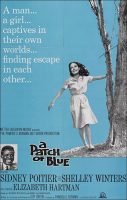Taglines: Love is color blind.
A Patch of Blue movie storyline. Accidentally blinded by her prostitute mother Rose-Ann at the age of five, Selina D’Arcey (Elizabeth Hartman) spends the next 13 years confined in the tiny Los Angeles apartment that they share with “Ole Pa”, Selina’s grandfather. One afternoon at the local park, Selina meets Gordon Ralfe (Sidney Poitier), a thoughtful young office worker whose kind-hearted treatment of her results in her falling in love with him, unaware that he is black.
They continue to meet in the park every afternoon and he teaches her how to get along in the city. But when the cruel, domineering Rose-Ann learns of their relationship, she forbids her to have anything more to do with him because he is black. Selina continues to meet Gordon despite Rose-Ann’s fury, who is determined to end the relationship for good.
A Patch of Blue is a 1965 American drama film directed by Guy Green about the friendship between an educated black man (played by Sidney Poitier) and an illiterate, blind, white, 18-year-old girl (played by Elizabeth Hartman), and the problems that plague their friendship in a racially divided America. Made in 1965 against the backdrop of the growing civil rights movement, the film explores racism while playing on the idea that “love is blind.”
Shelley Winters won the Academy Award for Best Supporting Actress, her second win for the award, following her victory in 1959 for The Diary of Anne Frank. It was the final screen appearance for veteran actor Wallace Ford. Scenes of Poitier and Hartman kissing were excised from the film when it was shown in film theaters in the Southern United States. These scenes are intact in the DVD version. According to the DVD audio commentary, it was the decision of director Guy Green that A Patch of Blue be filmed in black and white although color was available.
The film was adapted by Guy Green from the 1961 book Be Ready with Bells and Drums by the Australian author Elizabeth Kata. The book later won a Writers Guild of America award. The plot differs slightly from the film in that it has a less optimistic ending.
In addition to the Best Supporting Actress win for Winters, the film was nominated for Academy Awards for Best Actress in a Leading Role (Elizabeth Hartman), Best Art Direction-Set Decoration (Black-and-White) (George Davis, Urie McCleary, Henry Grace, Charles S. Thompson), Best Cinematography (Black-and-White) and Best Music (Original Music Score). Hartman, 22 at the time, was the youngest Best Actress nominee, a record she held for 10 years before 20-year-old Isabelle Adjani broke her record in 1975.
The soundtrack to A Patch of Blue was composed and conducted by Jerry Goldsmith. It gained Goldsmith his second Academy Award nomination for Best Original Score following his score to Freud in 1962. It was one of the 250 nominated scores for the American Film Institute’s top 25 American film scores. The score has been released three times on CD; in 1991 through Mainstream Records (with the score to David and Lisa by Mark Lawrence), in 1992 through Tsunami Records (with his score to Patton), and an extended version in 1997 through Intrada Records.
A Patch of Blue (1965)
Directed by: Guy Green
Starring: Sidney Poitier, Shelley Winters, Elizabeth Hartman, Wallace Ford, Ivan Dixon, Elisabeth Fraser, John Qualen, Renata Vanni, Debi Storm, Kelly Flynn, Dorothy Lovett
Screenplay by: Guy Green
Production Design by: Lindsley Parsons Jr.
Cinematography by: Robert Burks
Film Editing by: Rita Roland
Set Decoration by: Henry Grace, Charles S. Thompson
Art Direction by: George W. Davis, Urie McCleary
Music by: Jerry Goldsmith
MPAA Rating: None.
Distributed by: Metro-Goldwyn-Mayer
Release Date: December 10, 1965
Views: 250


